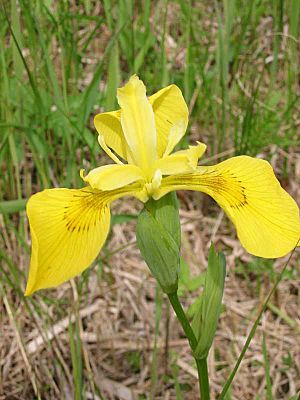Iridaceae facts for kids
Quick facts for kids Iris family |
|
|---|---|
 |
|
| Iris pseudacorus | |
| Scientific classification | |
| Kingdom: | |
| Division: | |
| Class: | |
| Order: | |
| Family: |
Iridaceae
|
| Subfamilies and tribes | |
|
|
The Iridaceae family, also known as the Iris family, is a large group of flowering plants. These plants are usually perennial herbs, which means they live for more than two years. They grow from special underground storage parts like rhizomes (thick stems), bulbs (like an onion), or corms (solid, swollen stems).
There are about 80 different types of plant groups (called genera) and around 1,500 different species in this family. Many of these plants are known for their very showy and colorful flowers.
Contents
What are Iridaceae Plants Like?
Iridaceae plants have unique features that help identify them. Their leaves grow in two rows, one on each side of the stem. This is called being distichous. The base of the leaves wraps around the stem, like a sheath.
Leaves and Stems
The leaves often have a flat, sword-like shape or are long and narrow. They have veins that run parallel to each other, from the base to the tip. This is a common feature in plants called monocots.
Flowers and How They Grow
The flowers of the Iris family are usually quite beautiful and can be very colorful. They are bisexual, meaning each flower has both male and female parts. This allows them to produce seeds.
Some flowers are actinomorphic, which means they are symmetrical all around, like a star. Others are zygomorphic, meaning they have symmetry only along one line, like a human face. This variety makes them very interesting to look at.
Where Do Iris Family Plants Live?
Plants from the Iris family can be found all over the world. They grow in many different climates and habitats. You can find them in sunny meadows, damp forests, and even rocky mountain slopes.
Common Places to Find Them
Many species are native to South Africa, which is a hotspot for Iridaceae diversity. Others are found in Europe, Asia, and North America. They have adapted to survive in various conditions, from very cold winters to hot, dry summers.
Famous Members of the Iris Family
Many well-known garden plants belong to the Iridaceae family. You might have seen some of these beautiful flowers in parks or gardens.
Some common examples include:
- Gladiolus: Often called "sword lilies" because of their tall, sword-shaped leaves and large, colorful flowers. They are popular as cut flowers.
- Ixia: These are smaller plants, often called "corn lilies." They have delicate, star-shaped flowers that come in many bright colors.
- Iris: This is the most famous member and gives the family its name. Iris flowers are known for their unique shape and wide range of colors, including blue, purple, white, and yellow.
- Libertia: These plants have attractive white or yellow flowers and are often grown for their ornamental value.
Life Cycle and Reproduction
Iridaceae plants reproduce mainly through their flowers and seeds. They also use their underground storage organs to spread and survive.
How They Spread
The rhizomes, bulbs, and corms help these plants store food and energy. This allows them to survive harsh conditions, like winter or dry periods. When conditions are right, new shoots and flowers can grow from these stored parts. This is a type of vegetative reproduction.
Pollination and Seeds
Like many flowering plants, Iridaceae rely on pollinators, such as bees, butterflies, and hummingbirds, to carry pollen between flowers. After successful pollination, the flowers produce seeds. These seeds can then be dispersed by wind, water, or animals, helping the plants spread to new areas.
Importance of Iridaceae
The Iris family is important for several reasons. Many species are grown as ornamental plants because of their beautiful flowers. They add color and beauty to gardens and landscapes around the world.
Uses and Value
Some Iridaceae species are also used in traditional medicine. Others are important for their role in ecosystems, providing food and habitat for various insects and animals. The diversity of this family makes it a fascinating group for botanists and plant lovers alike.
See also
 In Spanish: Iridáceas para niños
In Spanish: Iridáceas para niños

